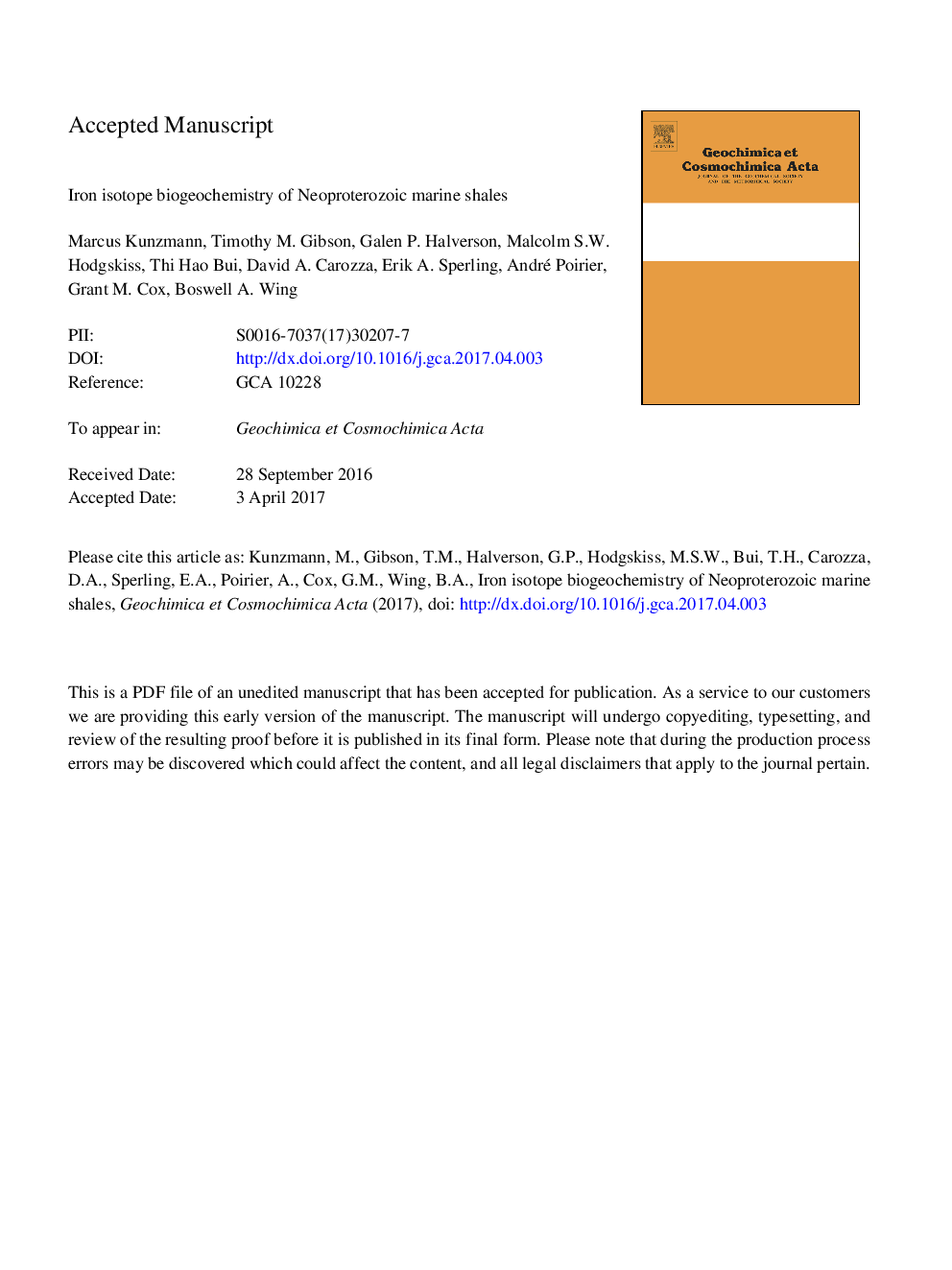| کد مقاله | کد نشریه | سال انتشار | مقاله انگلیسی | نسخه تمام متن |
|---|---|---|---|---|
| 5783278 | 1637948 | 2017 | 70 صفحه PDF | دانلود رایگان |
عنوان انگلیسی مقاله ISI
Iron isotope biogeochemistry of Neoproterozoic marine shales
ترجمه فارسی عنوان
بیوتکنولوژی ایزوتوپ آهن شیلات دریایی نئوپروتروزوئیک
دانلود مقاله + سفارش ترجمه
دانلود مقاله ISI انگلیسی
رایگان برای ایرانیان
کلمات کلیدی
موضوعات مرتبط
مهندسی و علوم پایه
علوم زمین و سیارات
ژئوشیمی و پترولوژی
چکیده انگلیسی
Iron isotopes have been widely applied to investigate the redox evolution of Earth's surface environments. However, it is still unclear whether iron cycling in the water column or during diagenesis represents the major control on the iron isotope composition of sediments and sedimentary rocks. Interpretation of isotopic data in terms of oceanic redox conditions is only possible if water column processes dominate the isotopic composition, whereas redox interpretations are less straightforward if diagenetic iron cycling controls the isotopic composition. In the latter scenario, iron isotope data is more directly related to microbial processes such as dissimilatory iron reduction. Here we present bulk rock iron isotope data from late Proterozoic marine shales from Svalbard, northwestern Canada, and Siberia, to better understand the controls on iron isotope fractionation in late Proterozoic marine environments. Bulk shales span a δ56Fe range from â0.45â° to +1.04â°. Although δ56Fe values show significant variation within individual stratigraphic units, their mean value is closer to that of bulk crust and hydrothermal iron in samples post-dating the ca. 717-660 Ma Sturtian glaciation compared to older samples. After correcting for the highly reactive iron content in our samples based on iron speciation data, more than 90% of the calculated δ56Fe compositions of highly reactive iron falls in the range from ca. â0.8â° to +3â°. An isotope mass-balance model indicates that diagenetic iron cycling can only change the isotopic composition of highly reactive iron by <1â°, suggesting that water column processes, namely the degree of oxidation of the ferrous seawater iron reservoir, control the isotopic composition of highly reactive iron. Considering a long-term decrease in the isotopic composition of the iron source to the dissolved seawater Fe(II) reservoir to be unlikely, we offer two possible explanations for the Neoproterozoic δ56Fe trend. First, a decreasing supply of Fe(II) to the ferrous seawater iron reservoir could have caused the reservoir to decrease in size, allowing a higher degree of partial oxidation, irrespective of increasing environmental oxygen levels. Alternatively, increasing oxygen levels would have led to a higher proportion of Fe(II) being oxidized, without decreasing the initial size of the ferrous seawater iron pool. We consider the latter explanation as the most likely. According to this hypothesis, the δ56Fe record reflects the redox evolution of Earth's surface environments. δ56Fe values in pre-Sturtian samples significantly heavier than bulk crust and hydrothermal iron imply partial oxidation of a ferrous seawater iron reservoir. In contrast, mean δ56Fe values closer to that of hydrothermal iron in post-Sturtian shales reflects oxidation of a larger proportion of the ferrous seawater iron reservoir, and by inference, higher environmental oxygen levels. Nevertheless, significant iron isotopic variation in post-Sturtian shales suggest redox heterogeneity and possibly a dominantly anoxic deep ocean, consistent with results from recent studies using iron speciation and redox sensitive trace metals. However, the interpretation of generally increasing environmental oxygen levels after the Sturtian glaciation highlights the need to better understand the sensitivity of different redox proxies to incremental changes in oxygen levels to enable us to reconcile results from different paleoredox proxies.
ناشر
Database: Elsevier - ScienceDirect (ساینس دایرکت)
Journal: Geochimica et Cosmochimica Acta - Volume 209, 15 July 2017, Pages 85-105
Journal: Geochimica et Cosmochimica Acta - Volume 209, 15 July 2017, Pages 85-105
نویسندگان
Marcus Kunzmann, Timothy M. Gibson, Galen P. Halverson, Malcolm S.W. Hodgskiss, Thi Hao Bui, David A. Carozza, Erik A. Sperling, André Poirier, Grant M. Cox, Boswell A. Wing,
